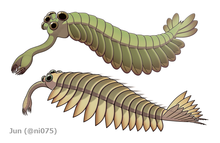Opabiniidae is an extinct family of marine stem-arthropods.[1] Its type and best-known genusisOpabinia. It also contains Utaurora, and Mieridduryn. Opabiniids closely resemble radiodonts, but their frontal appendages were basally fused into a proboscis. Opabiniids also distinguishable from radiodonts by setal blades covering at least part of the body flaps and serrated caudal rami.[2]
| Opabiniidae
| |
|---|---|

| |
| Opabinia (top) and Utaurora (bottom) | |
| Scientific classification | |
| Domain: | Eukaryota |
| Kingdom: | Animalia |
| Phylum: | Arthropoda |
| Class: | †Dinocaridida |
| Family: | †Opabiniidae Walcott, 1912 |
| Genera | |


Opabiniidae was named by Charles Doolittle Walcott in 1912, alongside its type species Opabinia. Walcott interpreted Opabiniidae as a family of anostracan crustaceans, most closely related to Thamnocephalidae.[3] Opabinia was restudied in the 1970s, and reinterpreted as a stranger animal. Stephen Jay Gould referred to Opabinia as a "weird wonder", and an illustration of Opabinia prompted laughter when it was first revealed at a paleontological conference.[4] In 2022, more Opabiniids were discorvered. That being Utaurora, and Mieridduryn.[2]
Myoscolex from Emu Bay Shale is sometimes suggested to be an opabiniid,[5] but morphological features supporting this interpretation are controversial.[6][2]